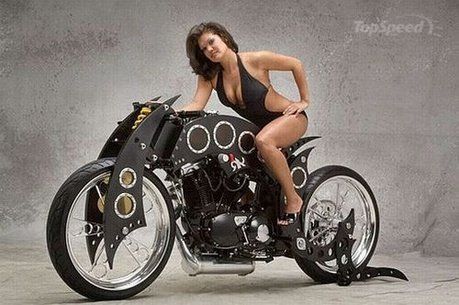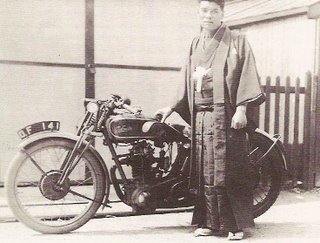
Fay Taylour was the most famous woman motorcyclist in the late 1920's, and a champion speedway competitor. Born 1904 in Ireland, by the age of 21 she was traveling the world, racing on the incredibly popular speedway tracks in England, Australia, and New Zealand. The popularity of this sport in the late 20's is difficult to imagine, as it caught the public imagination like wildfire, after the sport arrived from Australia. Races which were expected to attract 1,000 spectators were suddenly swamped with 20,000 people, causing great difficulties with crowd and traffic control, but making promoters (and ultimately riders) a lot of money in the day.
Fay was quoted in an Australian newspaper in 1930, "
“All my life I have enjoyed sports of all kinds, and when I chanced to come upon motor cycling I took to it at once, and loved going at speed. And I’ve always loved mechanical things – anything with wheels. When I was quite a tiny tot I would prefer playing with toy engines rather than dolls.
“Whilst I think that dirt-track racing is essentially for men, because they are stronger and better fitted to meet the strain, I do not think it should be taboo for women who can prove themselves capable.

“If a woman is strong enough and enjoys the thrills, if she can take the sport as the men do, she is in for a good time. But she has to exercise greater care, for it is easier for her to overdo things. Nevertheless, she need not lose her femininity over the job. I know there are people who think that there is something abominable about a woman on the dirt-track. But it merely shows her adaptability. She can be just as normal in the leather gear of a speed merchant as she is in a billowy evening frock.
“When, three years ago, I got my first motorbike, I was told I should break my neck. But I didn’t! In fact, I entered for the Southern Scots Scramble at Camberley in that same year. It was a gruelling test for both machine and rider, but more especially for the rider.
“Think of it! Forty-eight miles of rough going over hills, up and down. Much against his will, and after a great deal of persuasion, an uncle had financed me for this event. I had sworn to win it! He didn’t believe it possible. But, I felt it was, because I wanted it to be the means of making a new career. So I kept on saying to myself: ‘Girl, you must win!’ And win I did! From that date my career as a racing motorcyclist began.

But it costs money to become a recognised racing motorcyclist, and, what is more, a woman has to face a great deal of opposition before anyone will take her seriously. I approached the manufacturers. But at that time they felt that my riding was too wild. Apparently they could get no advertisement out of my exhibitions because my stuff would not appeal to women riders.
“And then I had a road accident, injuring my knee. A specialist advised an operation, which was successful. I then got work with a firm of motorcycle manufacturers in their showrooms at Birmingham.
“But I wanted speed. I had won a score or so of cups, but you can’t live on cups! When, in the early part of last year, I saw the dirt track speeding, I made up my mind to go in for these new thrills. I was refused admission to three speedway tracks, one after the other.

“Then, whilst the officials were in the Isle of Man last year for the T.T. races, I took advantage of their absence to test myself on the dirt track at Crystal Palace. The result was that, by the time they returned, I was able to show them efficiency in the new sport.
“I was established, and, as is generally known, I made the most of my opportunities there during the summer of last year. Even a woman can get what she wants, when her want is strong enough.
“Then came my Australian tour. I was repeatedly told that the Australians would not allow a woman to ride on their tracks. But I was given my chance, and put up the fastest time of the meetings at several States when I defeated well-known champions.

Our tracks are much smaller than the Australian dirt tracks, which, I think, makes racing here more of a nerve test. The smaller the track, the more bends in a given distance, and the more thrills.”
In the top photos, she's sitting on a racing Douglas DT5, a 500cc ohv flat-twin, with an extremely low center of gravity, which suited the leg-trailing riding style on the cinder tracks at that time. It was THE unbeatable machine of the 1927/'28/'29 seasons, later challenged by Rudge, and JAP specialist machines.
Women were banned from ALL speedway tracks in England in 1930, so Fay switched to racing cars, and became, naturally, very successful at that sport as well. She always carried a pair of satin pajamas in a suitcase to her racing venues, in case she had an accident - early in her career she had been hospitalized briefly, and hated the rough hospital gown she was forced to wear!

The fourth pic shows her ready to compete in the 1929 International Six Day's Trial, on a 500cc ohv Panther! Nor was she the only woman at the Trial in '29; there was a British Ladie's Vase Team, made up of Marjorie Cottle (348cc Raleigh), Edyth Foley (346cc Triumph), and Louie McLean (Douglas).
The ISDT that year went through 5 Countries (! - Germany, Austria, Switzerland, Italy, and France!) and was considered an organizational disaster - strange for any Germanic competition (it started in Munich), but the organizer's great ambition exceeded their grasp. The mountain passes were incredibly rough on the machines and riders, but Fay Taylor stuck the course to win a Silver Medal (as did Marjorie Cottle, Betty Lermite (Royal Enfield), and Louie MacLean).
During WW2, she was interned on the Isle of Man from 1940-43, for her pro-fascist views (! - she was friends with Sir Oswald Mosley, notorious founder of the British Union of Fascists in 1932), then released on condition she live in Ireland
 (which was neutral) for the duration of the war. Lesson #1; be careful having heroes, you never know what they're really thinking!
(which was neutral) for the duration of the war. Lesson #1; be careful having heroes, you never know what they're really thinking!Amazingly, after WW2, she came to the US and took up midget car racing, then returned in '53 to England, where she raced a 500cc Formula Cooper car (see last pic), until finally retiring from racing around 1959. She died in 1983.
Below is a video from around 1929 of Fay riding a Douglas DT5 - talk about rare footage! This is a sample from the British Pathe catalog; if you need the real film, you can pay them a fee for downloading a higher quality wmv or qt5 file.














